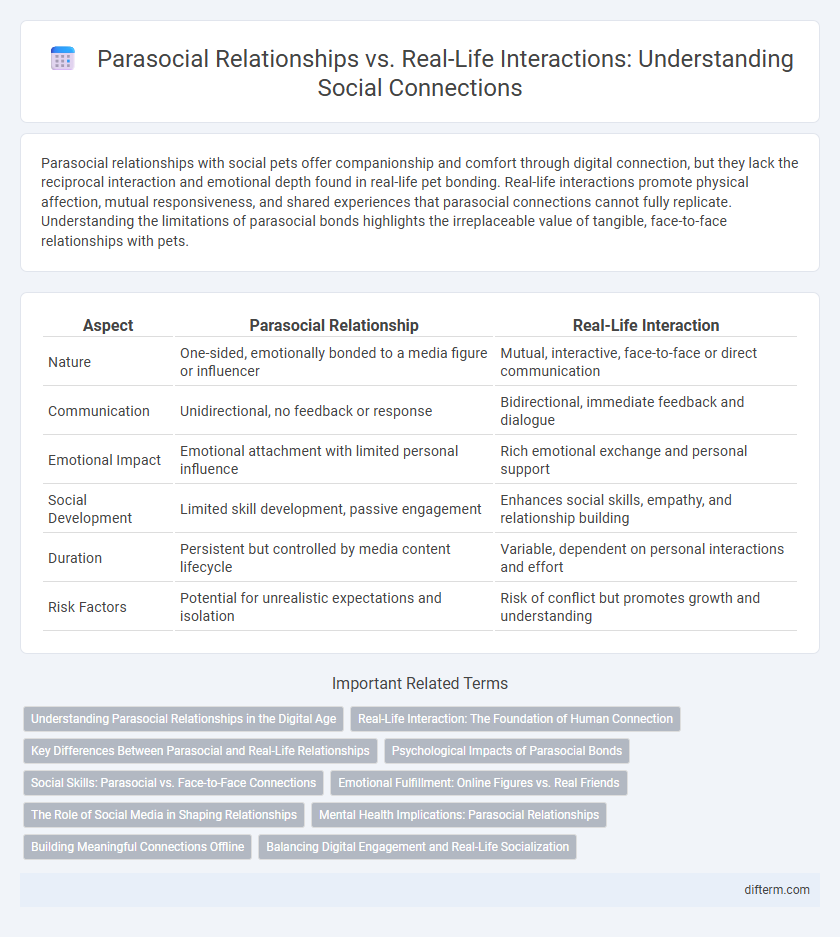Parasocial relationships with social pets offer companionship and comfort through digital connection, but they lack the reciprocal interaction and emotional depth found in real-life pet bonding. Real-life interactions promote physical affection, mutual responsiveness, and shared experiences that parasocial connections cannot fully replicate. Understanding the limitations of parasocial bonds highlights the irreplaceable value of tangible, face-to-face relationships with pets.
Table of Comparison
| Aspect | Parasocial Relationship | Real-Life Interaction |
|---|---|---|
| Nature | One-sided, emotionally bonded to a media figure or influencer | Mutual, interactive, face-to-face or direct communication |
| Communication | Unidirectional, no feedback or response | Bidirectional, immediate feedback and dialogue |
| Emotional Impact | Emotional attachment with limited personal influence | Rich emotional exchange and personal support |
| Social Development | Limited skill development, passive engagement | Enhances social skills, empathy, and relationship building |
| Duration | Persistent but controlled by media content lifecycle | Variable, dependent on personal interactions and effort |
| Risk Factors | Potential for unrealistic expectations and isolation | Risk of conflict but promotes growth and understanding |
Understanding Parasocial Relationships in the Digital Age
Parasocial relationships are one-sided emotional bonds where individuals feel connected to media figures or influencers despite no direct interaction. These digital-age connections often fulfill social needs but lack the reciprocity and depth found in real-life interactions. Understanding the psychological impact of parasocial engagement helps differentiate between virtual affection and genuine human connection.
Real-Life Interaction: The Foundation of Human Connection
Real-life interaction remains the cornerstone of authentic human connection, fostering empathy through physical presence, body language, and shared experiences that digital platforms cannot fully replicate. These interactions stimulate neurological responses linked to trust and emotional bonding, which are often muted in parasocial relationships with media figures or influencers. Prioritizing face-to-face communication strengthens social skills, resilience, and psychological well-being, underscoring its irreplaceable role in developing meaningful and reciprocal relationships.
Key Differences Between Parasocial and Real-Life Relationships
Parasocial relationships involve one-sided emotional connections where individuals feel attached to media personalities without direct interaction, unlike real-life relationships founded on mutual communication and shared experiences. Real-life interactions rely on reciprocal exchanges, body language, and emotional feedback, fostering deeper trust and understanding. Parasocial bonds offer comfort and admiration but lack the complexity and authenticity that characterize genuine interpersonal connections.
Psychological Impacts of Parasocial Bonds
Parasocial relationships create emotional connections where individuals perceive one-sided bonds with media figures, leading to feelings of companionship and support. These bonds can fulfill social needs, reduce loneliness, and provide comfort during times of stress, but may also hinder real-life social skills development and increase emotional dependency. Research indicates that while parasocial interactions offer psychological benefits, they should be balanced with genuine interpersonal relationships to maintain mental well-being.
Social Skills: Parasocial vs. Face-to-Face Connections
Parasocial relationships offer one-sided interactions where individuals engage with media figures without reciprocal communication, limiting opportunities to develop nuanced social skills like empathy and active listening. Face-to-face connections foster dynamic social exchanges, encouraging emotional intelligence and nonverbal cue recognition essential for building deeper interpersonal bonds. Research indicates that reliance on parasocial interactions may hinder real-life social competence and reduce adaptability in diverse social settings.
Emotional Fulfillment: Online Figures vs. Real Friends
Parasocial relationships with online figures offer a unique form of emotional fulfillment through constant accessibility and idealized interactions, providing a sense of belonging for audiences. However, real-life interactions with friends deliver deeper emotional satisfaction rooted in reciprocal empathy, shared experiences, and tangible support. Studies indicate that while parasocial bonds can reduce feelings of loneliness, they often lack the emotional reciprocity essential for long-term psychological well-being found in in-person relationships.
The Role of Social Media in Shaping Relationships
Social media platforms significantly influence parasocial relationships by enabling users to engage with celebrities and influencers through curated content, fostering a sense of personal connection despite one-sided interaction. These digital interactions often surpass real-life social exchanges in frequency and accessibility, shaping perceptions of intimacy and social fulfillment. The algorithm-driven nature of social media customizes content to deepen user attachment, blurring boundaries between parasocial bonds and genuine relationships.
Mental Health Implications: Parasocial Relationships
Parasocial relationships, characterized by one-sided emotional attachments to media figures, can impact mental health by providing comfort and companionship, especially during isolation. However, overreliance on these parasocial bonds may lead to increased feelings of loneliness, social anxiety, and impaired real-life social skills. Research indicates that balancing parasocial interactions with genuine social connections is crucial for maintaining emotional well-being and reducing the risk of social withdrawal.
Building Meaningful Connections Offline
Building meaningful connections offline fosters genuine emotional bonds that parasocial relationships often lack. Real-life interactions enable reciprocal communication, body language cues, and shared experiences essential for deep trust and understanding. Prioritizing face-to-face engagement enhances empathy and supports long-term social well-being beyond digital one-sided connections.
Balancing Digital Engagement and Real-Life Socialization
Balancing digital engagement and real-life socialization is crucial for maintaining healthy parasocial relationships without compromising genuine human connection. Excessive online interaction with digital personas can lead to social isolation, while integrating face-to-face conversations fosters emotional well-being and communication skills. Prioritizing time for in-person activities alongside moderated digital consumption supports mental health and enriches social experiences.
parasocial relationship vs real-life interaction Infographic

 difterm.com
difterm.com